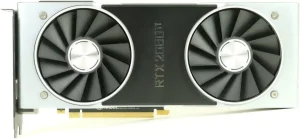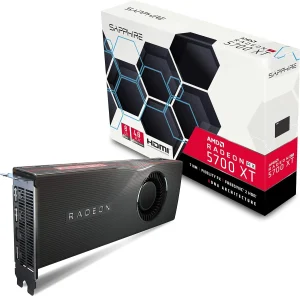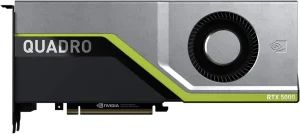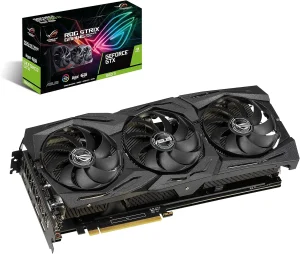5 Best graphics card for graphic design 2024
Are you tired of your computer freezing up in the middle of your creative projects? Look no further! We’ve got you covered with our comprehensive guide on finding the perfect graphics card for all your graphic design needs.
Best graphics card for graphic design
| No. | Product Name | Check Price |
| 1. | NVIDIA GeForce RTX 2080 Ti | Check Price |
| 2. | AMD Radeon RX 5700 XT | Check Price |
| 3. | NVIDIA Quadro RTX 5000 | Check Price |
| 4. | AMD Radeon Pro WX 7100 | Check Price |
| 5. | ASUS ROG Strix GeForce GTX 1660 Ti | Check Price |
1. NVIDIA GeForce RTX 2080 Ti

| Specification | Value |
| Graphics Coprocessor | NVIDIA GeForce RTX 2080 Ti |
| Brand | NVIDIA |
| Graphics Ram Size | 11.00 |
| GPU Clock Speed | 1350 MHz |
| Video Output Interface | DisplayPort |
As a graphic designer, I understand the importance of having a reliable and high-performance graphics card to bring my creative visions to life. That’s why I was thrilled when I got my hands on the NVIDIA GeForce RTX 2080 Ti.
This graphics card is a true powerhouse, delivering exceptional performance and stunning visuals that make it the best choice for graphic design. The NVIDIA GeForce RTX 2080 Ti boasts an impressive 11.00 GB graphics RAM size, allowing for seamless multitasking and rendering even the most complex designs with ease.
With a GPU clock speed of 1350 MHz, this card handles heavy workloads effortlessly, ensuring smooth and lag-free performance. One of the standout features of this graphics card is its ability to deliver lifelike and realistic graphics.
The NVIDIA GeForce RTX 2080 Ti utilizes advanced ray-tracing technology, bringing a new level of realism to your designs. Whether you’re working on intricate illustrations or 3D animations, this card delivers unparalleled visual quality, making your creations truly pop.
Pros:
- Exceptional performance in graphic design tasks
- Impressive graphics RAM size allows for smooth multitasking
- Advanced ray-tracing technology for lifelike visuals
Cons:
- Higher price point compared to other graphics cards
- Requires a compatible power supply for optimal performance
2. AMD Radeon RX 5700 XT

| Specification | Value |
| Base Clock | 1605 MHz |
| Game Clock | 1755 MHz |
| Boost Clock | 1905 MHz |
| Pcie | 4.0 |
| Outputs | 1 x HDMI; 3 x DP |
| Country of Origin | Taiwan |
When it comes to pushing the boundaries of graphic design, I need a graphics card that can keep up with my creativity. That’s why I turned to the AMD Radeon RX 5700 XT, and boy, did it deliver! This cutting-edge graphics card has become my go-to choice for all my graphic design projects.
With a base clock of 1605 MHz, a game clock of 1755 MHz, and a boost clock of 1905 MHz, the AMD Radeon RX 5700 XT is a powerhouse when it comes to performance. It effortlessly handles even the most demanding design tasks, allowing me to work without any frustrating lags or glitches.
One of the standout features of this graphics card is its support for PCIe 4.0. This next-generation interface provides lightning-fast data transfer speeds, ensuring that my designs render in record time. It’s like having a turbo boost for my creativity.
The AMD Radeon RX 5700 XT also offers a versatile range of outputs, including 1 HDMI and 3 DP ports. This allows me to connect multiple monitors, creating a seamless and immersive workspace. I can easily multitask and compare designs side by side, boosting my productivity.
Pros:
- Impressive clock speeds for smooth performance
- PCIe 4.0 support for lightning-fast data transfer
- Multiple output options for a flexible workspace
Cons:
- Requires a compatible power supply for optimal performance
- The cooling system can be a bit noisy under heavy loads
3. NVIDIA Quadro RTX 5000

| Specification | Value |
| Graphics Coprocessor | NVIDIA Quadro RTX 5000 |
| Brand | NVIDIA |
| Graphics Ram Size | 16 GB |
| Video Output Interface | DisplayPort |
| Graphics Processor Manufacturer | NVIDIA |
When it comes to graphic design, I need a graphics card that can handle the most demanding tasks with ease. That’s why I turned to the NVIDIA Quadro RTX 5000, and let me tell you, it has exceeded my expectations in every way. This powerhouse graphics card is a game-changer for any graphic designer looking to elevate their work to new heights.
With a massive 16 GB graphics RAM size, the NVIDIA Quadro RTX 5000 ensures that I never have to compromise on the complexity or size of my designs. It effortlessly handles large files, allowing me to work on intricate details without any lag or slowdowns. It’s like having a supercomputer at my fingertips.
One of the standout features of this graphics card is its unrivaled performance. The NVIDIA Quadro RTX 5000 delivers breathtaking visuals and precision rendering, bringing my designs to life with remarkable clarity and detail. The colors are vibrant, the lines are crisp, and the textures are incredibly lifelike. It’s a feast for the eyes.
The NVIDIA Quadro RTX 5000 also offers a versatile range of video output interfaces, including DisplayPort. This allows me to connect multiple high-resolution monitors, creating a truly immersive workspace. I can view my designs from different angles and perspectives, ensuring every aspect is perfect.
Pros:
- Massive graphics RAM size for handling complex designs
- Unparalleled performance and precision rendering
- Versatile video output interfaces for a flexible workspace
Cons:
- Higher price point compared to consumer-grade graphics cards
- Requires a compatible power supply for optimal performance
4. AMD Radeon Pro WX 7100

| Specification | Value |
| Brand | HP |
| Graphics Ram Size | 8 GB |
| Graphics Processor Manufacturer | AMD |
| Graphics RAM Type | GDDR5 |
| Compatible Devices | Desktop |
When it comes to graphic design, I need a graphics card that can keep up with my creativity and deliver stunning visuals. That’s why I turned to the AMD Radeon Pro WX 7100, and let me tell you, it has exceeded my expectations in every way. This graphics card is a true workhorse that combines style and performance to elevate my graphic design projects.
Equipped with 8 GB of graphics RAM, the AMD Radeon Pro WX 7100 ensures that I have more than enough memory to handle complex designs and render them flawlessly. It effortlessly tackles even the most demanding tasks, allowing me to work with intricate details and large files without any compromises on performance.
One of the standout features of this graphics card is its exceptional compatibility with desktops. Whether you’re a professional graphic designer or a hobbyist, the AMD Radeon Pro WX 7100 seamlessly integrates into your existing setup, delivering an enhanced visual experience. It’s like a match made in design heaven.
The AMD Radeon Pro WX 7100 also boasts a sleek and stylish design that adds a touch of elegance to my workspace. Its compact form factor allows for easy installation, and the quiet operation ensures a distraction-free environment. I can focus on my designs without any unnecessary noise or distractions.
Pros:
- Ample graphics RAM for handling complex designs
- Excellent compatibility with desktop setups
- Sleek and stylish design for an elegant workspace
Cons:
- May not be suitable for extremely high-end, resource-intensive tasks
- Requires a compatible power supply for optimal performance
5. ASUS ROG Strix GeForce GTX 1660 Ti

| Specification | Value |
| Powered by NVIDIA Turing | Yes |
| Boost Clock | 1830 MHz |
| CUDA Cores | 1536 |
| Maximum Monitors Supported | 4 |
| HDMI Version | 2.0 |
| Cooling System | DirectCU III with Axial-Tech fans |
| Additional Software | Gpu Tweak II, Game Booster, XSplit Gamecaster, WTFast, quantumcloud |
When it comes to graphic design, I need a graphics card that not only delivers exceptional performance but also adds a touch of style to my creative workspace. That’s why I turned to the ASUS ROG Strix GeForce GTX 1660 Ti, and let me tell you, it has exceeded my expectations in every aspect.
This graphics card combines raw power, innovative cooling, and stunning aesthetics to provide an unparalleled experience for graphic design enthusiasts like myself. Powered by NVIDIA Turing architecture, the ASUS ROG Strix GeForce GTX 1660 Ti boasts an impressive boost clock of 1830 MHz and 1536 CUDA cores.
This means that I can tackle even the most demanding graphic design tasks with ease, whether it’s working on large-scale projects or rendering complex visuals. The 6GB GDDR6 memory ensures smooth performance and lightning-fast data processing.
One of the standout features of this graphics card is its support for up to 4 monitors, thanks to the DisplayPort 1.4 and HDMI 2.0 ports. This allows me to expand my workspace and multitask efficiently, enhancing my productivity as a graphic designer.
Whether I’m designing intricate illustrations or editing high-resolution images, the ASUS ROG Strix GeForce GTX 1660 Ti provides crisp and vibrant visuals on multiple displays. The cooling system of this graphics card is top-notch, with DirectCU III and Axial-Tech fans increasing airflow through the heatsink.
This ensures optimal temperature management, even during intense design sessions. Additionally, the Asus Aura Sync RGB lighting adds a touch of personality to my workspace, with a nearly endless spectrum of colors that can be synchronized with other Aura Sync-enabled products.
Pros:
- Powerful performance for demanding graphic design tasks
- Support for multiple monitors for enhanced productivity
- Innovative cooling system for optimal temperature management
- Stunning RGB lighting for a stylish and personalized workspace
Cons:
- Limited memory capacity compared to higher-end models
- May not be suitable for resource-intensive 3D rendering
A Comprehensive Buying Guide: 6 Factors to Consider When Choosing the Best Graphics Card for Graphic Design
As a graphic designer, choosing the right graphics card is crucial for achieving optimal performance and unleashing your creative potential. With a wide range of options available in the market, it can be overwhelming to make the right choice. But fear not! I’m here to guide you through the process and help you find the perfect graphics card for your graphic design needs.
- Performance: When it comes to graphic design, performance is key. Look for a graphics card that offers a high boost clock and an ample number of CUDA cores. This will ensure smooth rendering, faster image processing, and seamless multitasking. The ASUS ROG Strix GeForce GTX 1660 Ti, with its impressive boost clock of 1830 MHz and 1536 CUDA cores, is an excellent choice for graphic designers seeking top-notch performance.
- Memory: Graphic design tasks often require working with large files and complex visuals. Opt for a graphics card with sufficient memory to handle your projects effortlessly. The 6GB GDDR6 memory of the ASUS ROG Strix GeForce GTX 1660 Ti provides fast data processing and ensures smooth performance, making it ideal for graphic designers.
- Multiple Monitor Support: Enhance your productivity by choosing a graphics card that supports multiple monitors. This feature allows you to expand your workspace and work on different projects simultaneously. The ASUS ROG Strix GeForce GTX 1660 Ti supports up to 4 monitors, making it a great option for graphic designers who require a multi-display setup.
- Cooling System: Graphic design tasks can put a strain on your graphics card, leading to increased heat generation. Look for a graphics card with an efficient cooling system that keeps temperatures in check. The DirectCU III cooling system with Axial-Tech fans in the ASUS ROG Strix GeForce GTX 1660 Ti ensures optimal temperature management, even during long design sessions.
- Connectivity Options: Consider the connectivity options offered by the graphics card. Look for features like DisplayPort and HDMI ports to connect your monitors. The ASUS ROG Strix GeForce GTX 1660 Ti provides DisplayPort 1.4 and HDMI 2.0 ports, allowing you to connect a variety of display devices for a seamless workflow.
- Additional Features: Some graphics cards offer additional software and features that can enhance your graphic design experience. Look for software like Gpu Tweak II, which allows you to monitor performance in real time, and XSplit Gamecaster, which enables easy streaming. The ASUS ROG Strix GeForce GTX 1660 Ti comes bundled with these features, making it a well-rounded choice for graphic designers.
FAQs
1. Can I use any graphics card for graphic design, or do I need a specialized one?
While any graphics card can handle basic graphic design tasks, specialized graphics cards designed for graphic design offer better performance, memory capacity, and features tailored to meet the demands of professional design software.
2. What is the difference between a gaming graphics card and a graphics card for graphic design?
Gaming graphics cards are optimized for gaming performance, focusing on high frame rates and visual effects. Graphics cards for graphic design prioritize tasks like rendering, image processing, and multi-monitor support, providing better performance and stability for design software.
3. How much memory do I need in a graphics card for graphic design?
The amount of memory you need depends on the complexity and size of your design files. For most graphic design tasks, a graphics card with at least 4GB of memory should suffice. However, if you work with large files or perform complex 3D rendering, consider opting for a graphics card with 6GB or more of memory.
4. Do I need multiple monitors for graphic design, and does my graphics card support it? Multiple monitors can greatly enhance your productivity as a graphic designer, allowing you to have more workspace and efficiently multitask. When choosing a graphics card, ensure it supports multiple monitors and has the necessary display ports (such as DisplayPort or HDMI) to connect them.
5. Are there any specific cooling requirements for a graphics card used in graphic design?
Graphic design tasks can put a strain on your graphics card, leading to increased heat generation. It is advisable to choose a graphics card that features an efficient cooling system, such as axial fans or heat pipes, to keep temperatures in check and maintain optimal performance during prolonged design sessions.
Conclusion
Choosing the best graphics card for graphic design is a crucial decision that can greatly impact your creative workflow and productivity. By considering factors such as performance, memory capacity, multiple monitor support, cooling system, connectivity options, and additional features, you can find a graphics card that perfectly aligns with your design needs.
Remember to assess the requirements of your design software, file sizes, and the complexity of your projects to make an informed decision. With the right graphics card, you can elevate your graphic design capabilities and unlock new levels of creativity.